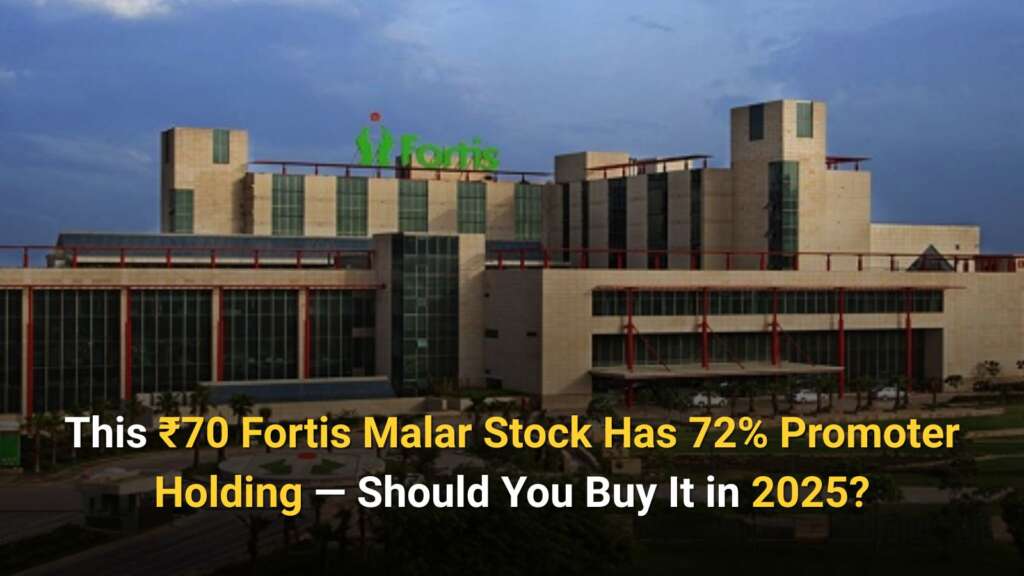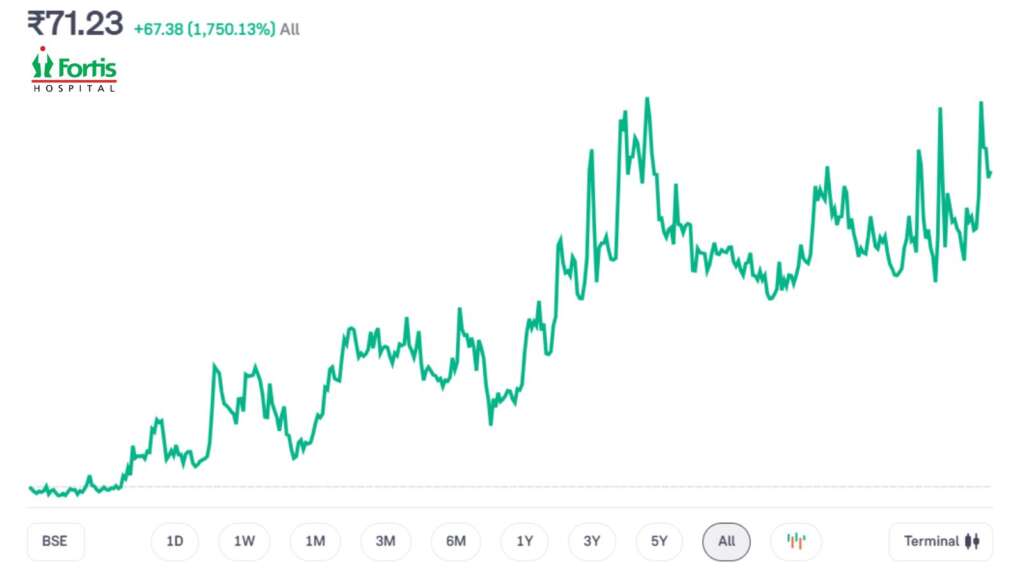
When retail traders search for hidden gems in India’s healthcare sector, one name that occasionally surfaces is Fortis Malar Hospitals Ltd. With a share price under ₹100, many believe this micro-cap stock could be a multibagger in the making.
But is it worth the risk?
In this comprehensive blog, we explore the Fortis Malar share price, its financials, stock performance, and how it differs from Fortis Healthcare share price, while helping traders decide whether this stock is an opportunity or a trap.
What is Fortis Malar Hospitals Ltd.?
Fortis Malar is a Chennai-based multi-specialty hospital that came under the Fortis Group in 2008. While Fortis Healthcare Ltd. operates a chain of hospitals nationwide, Fortis Malar functions as a smaller, independent, and separately listed entity under the same brand. It is headquartered in Adyar, Chennai, and provides services in cardiology, neurology, orthopedics, and general medicine.
Fortis Malar Share Price in 2025

As of mid-2025, the share price of Fortis Malar hovers around ₹70. The 52-week high and low stand at ₹88 and ₹48 respectively, indicating moderate volatility in the stock. With a market capitalization of ₹170 crores, it remains a micro-cap stock with limited institutional interest. The promoter holding is over 72%, which leaves very little room for public trading, resulting in low float and high sensitivity to buy/sell orders. Importantly, there is no meaningful P/E ratio due to inconsistent earnings, and the stock doesn’t offer any dividend yield, reflecting a company that reinvests what little profit it generates or carries losses.
Fortis Malar Share Snapshot
| Parameter | Value |
|---|---|
| Share Price | ₹70 |
| 52-Week High | ₹88 |
| 52-Week Low | ₹48 |
| Market Capitalization | ₹170 Cr |
| P/E Ratio | Not meaningful |
| Dividend Yield | 0% |
| Promoter Holding | 72%+ |
Fortis Malar vs Fortis Healthcare: A Clarification
Fortis Malar and Fortis Healthcare are often confused by retail traders. Fortis Healthcare is a pan-India hospital chain with over 30 facilities and a share price over ₹320, while Fortis Malar is a single-location hospital in Chennai trading at a fraction of that price. Fortis Healthcare boasts a market cap exceeding ₹23,000 crores, strong financials, and widespread institutional support. Fortis Malar, in contrast, is an isolated operation without the scale, cash flow, or growth trajectory of its parent. The confusion arises due to the similar branding, but from an investor’s point of view, they are vastly different opportunities.
Fortis Malar vs Fortis Healthcare
| Feature | Fortis Malar Hospitals Ltd. | Fortis Healthcare Ltd. |
| Listed Symbol | FORTISMALAR | FORTIS |
| Hospital Network | Single (Chennai) | 30+ across India |
| Share Price (NSE) | ₹70 | ₹320+ |
| Market Capitalization | ₹170 Cr | ₹23,000+ Cr |
| Institutional Interest | Low | High |
Financial Overview and Balance Sheet
Looking at Fortis Malar’s financials, its equity capital stands at ₹18 crores with reserves of approximately ₹25 crores. Total assets are in the ₹50–55 crore range, and the company has no long-term debt, giving it a debt-to-equity ratio of virtually zero. Being debt-free is a positive sign, but the stagnant nature of the balance sheet—with no visible investments in growth—suggests that the company is in maintenance mode rather than expansion mode. Its small asset base and limited reserves indicate a business that is surviving but not thriving.
Balance Sheet Overview
| Financial Metric | Value (FY24 Estimate) |
| Equity Capital | ₹18 Cr |
| Reserves | ₹25 Cr |
| Total Assets | ₹50–55 Cr |
| Long-Term Debt | Negligible |
| Debt-to-Equity Ratio | ~0 |
Cash Flow Analysis
The cash flow profile of Fortis Malar paints a picture of a company that lacks financial dynamism. Cash from operating activities is inconsistent, pointing to unstable earnings. Investing cash flow is minimal, suggesting very little reinvestment into new assets or expansion. Financing cash flow is flat as well, with no fresh capital inflow or borrowing. Overall, net cash flow fluctuates without a clear upward trend, limiting the company’s ability to scale up or deliver shareholder value.
Cash Flow Trends (Estimated)
| Cash Flow Component | Trend |
| Operating Cash Flow | Inconsistent |
| Investing Cash Flow | Minimal |
| Financing Cash Flow | Flat |
| Net Cash Flow | Volatile |
Trading Perspective: Opportunities and Challenges
Technically, the stock has seen support around the ₹58–60 range and faces resistance near ₹85–90. A price breakout is possible if the stock crosses ₹92 with high volume. Due to its low float, even modest trading volumes can cause large swings, making it attractive for short-term traders. However, this also makes it prone to pump-and-dump risks. The stock often reacts to Fortis Healthcare news and general sentiment in the healthcare sector. Without consistent financial results or corporate announcements, its rallies are speculative in nature.
Risk Factors
The biggest challenge for traders and investors is liquidity. Fortis Malar has low daily trading volumes, and any large buy or sell order can disproportionately affect the price. The absence of institutional holders further amplifies this risk. It has no consistent earnings history, does not pay dividends, and lacks visibility of long-term strategic planning. All these factors make the stock volatile and potentially risky for uninformed investors.
Key Risks Summary
| Risk Category | Level |
| Liquidity Risk | High |
| Price Volatility | High |
| Institutional Interest | Low |
| Dividend Yield | Zero |
| Long-Term Visibility | Weak |
Fortis Healthcare Share Price: A More Stable Option
In contrast, Fortis Healthcare offers a safer and more predictable investment in the healthcare space. With a share price of over ₹320, consistent revenues above ₹6,000 crores, and strong institutional interest, Fortis Healthcare delivers more reliable returns. The company has healthy return ratios, such as ROE and ROCE in the 10–12% range, and although dividend payouts are modest, they still add to shareholder value. For anyone seeking stable exposure to healthcare, Fortis Healthcare share price is a better indicator of quality and scalability than Fortis Malar.
Fortis Healthcare Fundamentals
| Metric | Value |
| Share Price | ₹320+ |
| Revenue | ₹6,000+ Cr |
| ROE / ROCE | 10–12% |
| Institutional Holding | High |
| Dividend Policy | Modest but consistent |
Should You Invest in Fortis Malar in 2025?
For long-term investors, the fundamentals do not support a strong buy. The company shows no signs of aggressive expansion or strategic transformation. For intraday and swing traders, the stock may offer speculative opportunities during spikes in volume or healthcare sector rallies, but even then, strict risk controls are necessary. For those purely interested in value investing, Fortis Malar may look undervalued, but without catalysts, it’s likely to remain a low-return asset.
Verdict by Investor Type
| Investor Type | Recommendation |
| Long-Term Investor | Avoid |
| Intraday Trader | Avoid (Low Liquidity) |
| Swing Trader | Watch for Volume Spike Opportunities |
| Speculative Investor | Small Exposure, High Caution |
Our Take: Buy, Hold, or Avoid Fortis Malar?
The Fortis Malar hospital share price may appeal to bargain hunters and speculative traders, but it doesn’t offer the consistency, scale, or security of Fortis Healthcare. Unless a corporate restructuring, merger, or privatization emerges, it’s best treated as a high-risk micro-cap play. Traders interested in the broader Fortis narrative should instead monitor Fortis Healthcare share price, Fortis share price NSE, and Fortis health share price.


Leave a Comment